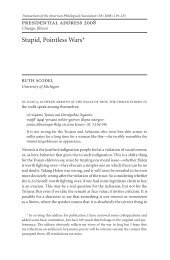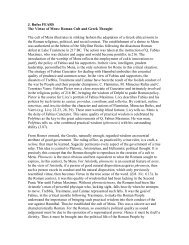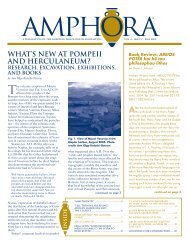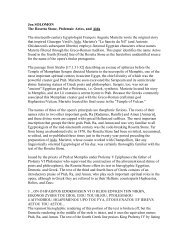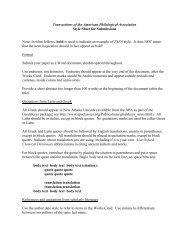classics rewritten in stone: the art of anita huffington - American ...
classics rewritten in stone: the art of anita huffington - American ...
classics rewritten in stone: the art of anita huffington - American ...
Create successful ePaper yourself
Turn your PDF publications into a flip-book with our unique Google optimized e-Paper software.
itself is a transformation <strong>of</strong> substance<br />
<strong>in</strong>to <strong>art</strong>. In addition, she sees Daphne as<br />
a symbol <strong>of</strong> women’s autonomy <strong>in</strong> that<br />
she represents “a woman’s choice to<br />
accept or reject even <strong>the</strong> love <strong>of</strong> a god”<br />
(Personal <strong>in</strong>terview. [27 Dec. 2006]).<br />
While many classicists might read this<br />
myth differently, Huff<strong>in</strong>gton’s Forest<br />
Figure, which is carved from a fragment<br />
<strong>of</strong> a tree, embodies her perspective: just<br />
as Daphne transforms from woman <strong>in</strong>to<br />
tree, Huff<strong>in</strong>gton transforms tree <strong>in</strong>to<br />
woman, restor<strong>in</strong>g to Daphne her female<br />
form and br<strong>in</strong>g<strong>in</strong>g her to life once aga<strong>in</strong>.<br />
Huff<strong>in</strong>gton’s focus on Daphne<br />
reflects a more general concern with<br />
women’s <strong>in</strong>terests <strong>in</strong> her work, most<br />
clearly seen <strong>in</strong> her preoccupation with<br />
<strong>the</strong> female form. Wallach notes that<br />
Huff<strong>in</strong>gton’s <strong>art</strong>istic career has its roots<br />
<strong>in</strong> New York dur<strong>in</strong>g an era <strong>of</strong> emerg<strong>in</strong>g<br />
fem<strong>in</strong>ism, when <strong>art</strong>ists like Huff<strong>in</strong>gton<br />
were “reclaim<strong>in</strong>g <strong>the</strong> female body from<br />
<strong>the</strong> male gaze” (“The Sculpture <strong>of</strong><br />
Anita Huff<strong>in</strong>gton: The Rock Is <strong>the</strong><br />
Habitation <strong>of</strong> <strong>the</strong> Whole.” Anita Huff<strong>in</strong>gton:<br />
Sources. [New York: O’Hara Gallery,<br />
2001], 5). While Huff<strong>in</strong>gton’s aims were<br />
more aes<strong>the</strong>tic than political – she was<br />
Fig. 20. Andromeda<br />
(1998). Photograph<br />
by Kirsten Day.<br />
Fig. 21. Birth <strong>of</strong> Venus<br />
(1999). Photograph by<br />
Kirsten Day.<br />
<strong>in</strong>terested <strong>in</strong> “[t]he beauty and vitality<br />
<strong>of</strong> <strong>the</strong> female form, and <strong>the</strong> strength<br />
and wisdom <strong>of</strong> <strong>the</strong> fem<strong>in</strong><strong>in</strong>e” (Wallach.<br />
[2001], 5) – her impulse towards fem<strong>in</strong><strong>in</strong>e<br />
empowerment is illustrated <strong>in</strong> figures<br />
like E<strong>art</strong>h and Gaea (Figs. 18 and<br />
19). “I have an association <strong>of</strong> <strong>the</strong> body<br />
with <strong>the</strong> e<strong>art</strong>h,” she says (Wallach.<br />
[2001], 5), and as <strong>the</strong>se sculptures suggest,<br />
Huff<strong>in</strong>gton envisions this e<strong>art</strong>hbody<br />
connection as fem<strong>in</strong><strong>in</strong>e, as have<br />
<strong>art</strong>ists from many cultures throughout<br />
history. As Fredric Koeppel notes,<br />
“Gaea projects a feel<strong>in</strong>g <strong>of</strong> fundamental,<br />
monumental power. With its thick<br />
thighs and broad shoulders . . . <strong>the</strong> piece<br />
resembles <strong>the</strong> ancient Venus <strong>of</strong><br />
Willendorf” (“Innocence Found – and<br />
Lost – Huff<strong>in</strong>gton’s Bronze Sculptures<br />
Restate <strong>the</strong> Terror and Serenity <strong>in</strong> <strong>the</strong><br />
Body Human,” The Commercial Appeal.<br />
Memphis, TN. [14 Jan. 2005]).<br />
Fem<strong>in</strong><strong>in</strong>e power and its relationship<br />
to nature are also demonstrated <strong>in</strong> works<br />
like Andromeda and Birth <strong>of</strong> Venus (Figs.<br />
20 and 21), which depict <strong>the</strong> female form<br />
emerg<strong>in</strong>g from <strong>the</strong> elements. While<br />
some critics see such works as betray<strong>in</strong>g<br />
pr<strong>of</strong>ound vulnerability, o<strong>the</strong>rs perceive<br />
<strong>the</strong>m as figures <strong>of</strong> strength and <strong>in</strong>dependence.<br />
Wallach notes that Andromeda<br />
balances on her knees, “as if on faith,<br />
only <strong>in</strong> <strong>the</strong> merest suggestion <strong>of</strong> battered<br />
rock and waves,” while Venus “thrusts<br />
forward her pelvis, arches and twists out<br />
<strong>of</strong> <strong>the</strong> rough-hewn column that suggests<br />
<strong>the</strong> legendary foam that gave her form”<br />
([2001], 7). In Wallach’s read<strong>in</strong>g, Huff<strong>in</strong>gton’s<br />
female forms emerge from <strong>the</strong>ir<br />
raw material, celebrat<strong>in</strong>g women’s autonomy<br />
<strong>in</strong> much <strong>the</strong> same way as Huff<strong>in</strong>gton<br />
envisions her Daphne figures. Mark<br />
Daniel Cohen recognizes a similar<br />
dynamic at play <strong>in</strong> <strong>the</strong> relationship <strong>of</strong><br />
Huff<strong>in</strong>gton’s work <strong>in</strong> general to <strong>the</strong> classical<br />
and archaic sculpture <strong>the</strong>y evoke:<br />
she “mak[es] her own what once<br />
belonged to o<strong>the</strong>rs,” he says. “She<br />
does not observably alter <strong>the</strong> style to<br />
own it, but she owns it by master<strong>in</strong>g<br />
it, and <strong>in</strong> <strong>the</strong> acquisition, it changes”<br />
(“The Shape <strong>of</strong> Time: Mix<strong>in</strong>g Memory<br />
and Desire. O’Hara Gallery<br />
through March 13,” Review. [1 March<br />
1999], 3).<br />
As <strong>the</strong>se observations suggest,<br />
Huff<strong>in</strong>gton views <strong>art</strong> as<br />
a means <strong>of</strong> understand<strong>in</strong>g<br />
and process<strong>in</strong>g life:<br />
as she puts it, “Art<br />
shows us life, enriches<br />
it, and helps us to bear<br />
its tragedy” (Artist’s statement.<br />
Anita Huff<strong>in</strong>gton:<br />
From <strong>the</strong> Forest. [New York:<br />
O’Hara Gallery, 2006]).<br />
Fig. 22. Rebirth (1982).<br />
Photograph by Kirsten Day.<br />
Fig. 23. Spr<strong>in</strong>g (1993).<br />
Photograph by Kirsten Day.<br />
Huff<strong>in</strong>gton’s <strong>art</strong> comb<strong>in</strong>es<br />
<strong>the</strong> personal and <strong>the</strong><br />
mythological.<br />
Indeed, <strong>art</strong> has helped Huff<strong>in</strong>gton come<br />
to terms with her own personal trials. In<br />
1982, Huff<strong>in</strong>gton was devastated when<br />
her daughter was killed by a drunk driver.<br />
She dealt with this tragedy by develop<strong>in</strong>g<br />
a personal connection to <strong>the</strong> myth <strong>of</strong><br />
Demeter and Persephone and draw<strong>in</strong>g<br />
on its <strong>the</strong>mes <strong>of</strong> loss and cont<strong>in</strong>uance<br />
when she returned to her work. The<br />
prevalence <strong>of</strong> this <strong>the</strong>me <strong>in</strong> <strong>the</strong> years<br />
s<strong>in</strong>ce Lisa’s death is unmistakable: while<br />
works like Rebirth and Spr<strong>in</strong>g (Figs. 22<br />
and 23) – both dedicated to <strong>the</strong> University<br />
<strong>of</strong> Arkansas <strong>in</strong> Lisa’s honor – allude<br />
obliquely to this myth, Persephone is<br />
more explicitly evoked <strong>in</strong> <strong>the</strong> 1991 work<br />
Huff<strong>in</strong>gton calls Kore (Fig. 24). But <strong>the</strong><br />
clearest expression <strong>of</strong> her engagement<br />
with this myth is found <strong>in</strong> Persephone<br />
(Fig. 1), begun not long after Lisa’s<br />
death. Like <strong>the</strong> Greek myth, Persephone<br />
exhibits both pa<strong>in</strong> and triumph. Wallach<br />
describes this sculpture as “a body as<br />
open wound. The alabaster is cracked<br />
and ve<strong>in</strong>ed <strong>in</strong> red, p<strong>art</strong>icularly at womb<br />
cont<strong>in</strong>ued on page 22<br />
Fig. 24. Kore (1991).<br />
Photograph by Kirsten Day.<br />
13



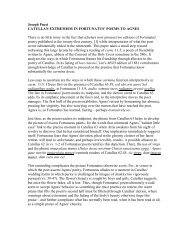
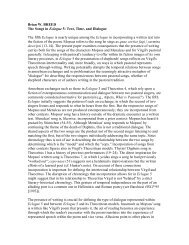
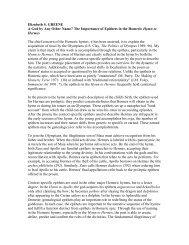

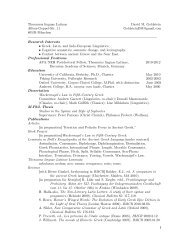
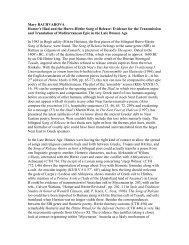

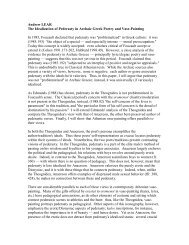
![John H. STARKS, Jr. [vo]cales vultus:Pantomime Actresses in Latin ...](https://img.yumpu.com/11930335/1/190x245/john-h-starks-jr-vocales-vultuspantomime-actresses-in-latin-.jpg?quality=85)
